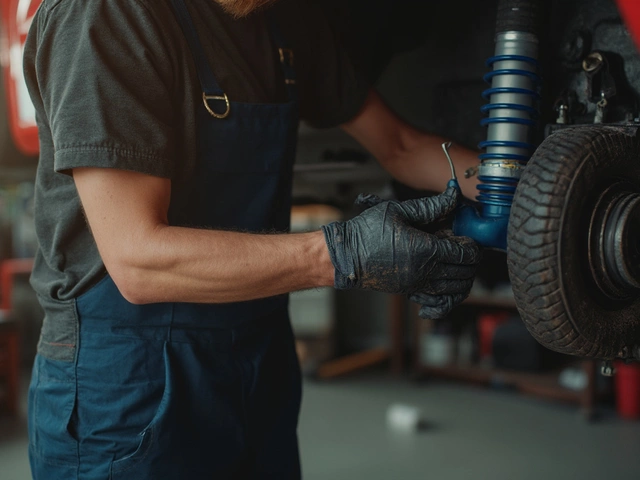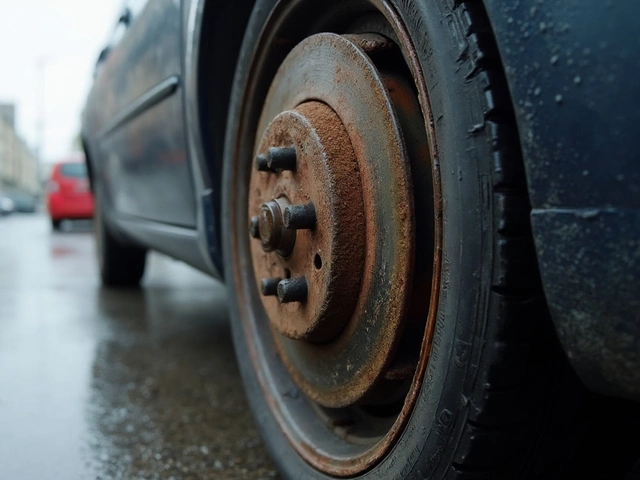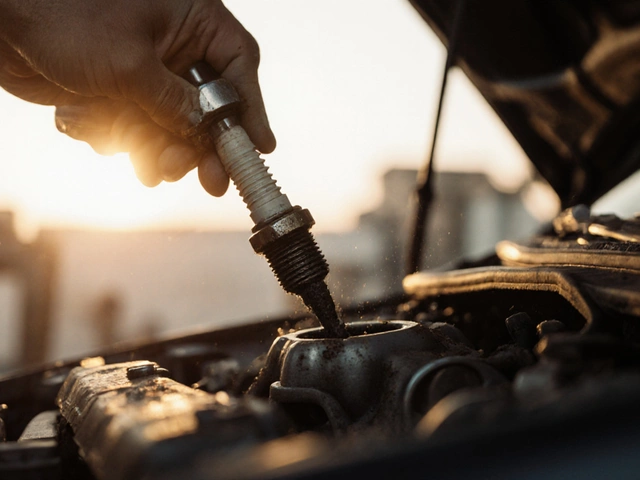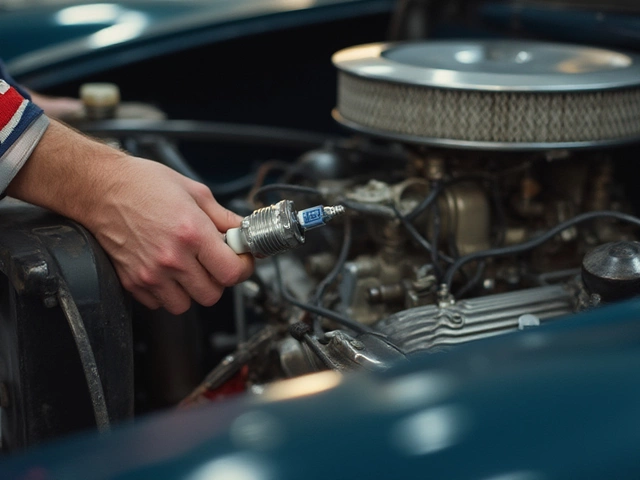Driving with bad shocks is like trying to keep balance on a seesaw that’s tilted in every wrong direction. It’s not just about comfort—though those bumps sure are annoying—it’s about the safety of everyone in the car. So, how long can you keep going before things get hairy?
First things first: why do shocks even matter? Well, they keep your tires firmly planted on the road, so you’re not just bouncing along as you face every little road bump. When shocks start to give out, that constant contact becomes a sketchy dance; your car can lose grip on the pavement. That's the last thing you want, especially when safety is on the line.
Stay tuned for spotting the early signs of shock failure. Maybe you’ve noticed a bit more play when you turn or felt your car dipping forward harshly when you brake. These aren't signs to ignore. They’re like your car's way of tapping you on the shoulder saying, "Hey, I need some attention!" Let's explore these indicators in our next bit.
- Why Shocks Matter
- Signs Your Shocks Are Failing
- Risks of Driving with Bad Shocks
- How Long Can You Drive?
- Tips for Maintaining Shock Health
Why Shocks Matter
Ever wonder why you can whip around a corner without tipping over or why your car doesn't bounce off the road after every little bump? It's thanks to those trusty shocks. When all is working well, they’re the heroes of your suspension system, keeping your car smooth and stable.
Think of suspension parts as the unsung bodyguards that protect your ride. At the heart of this system, shock absorbers keep your tires in firm contact with the road by absorbing and dissipating energy generated by the movement of the car. This contact is crucial because it affects how your car handles, brakes, and corners.
The Role of Shocks
Shocks aren’t just about a comfy ride, they're key for safety. First, they help control the vehicle's body motion during braking, accelerating, and taking corners. If you're cornering sharply or making an emergency stop, the last thing you need is for your car to bounce like a basketball.
- Brake Efficiency: Shocks help in distributing the weight of the vehicle evenly. Without them, braking distances can increase, which is no good in emergency situations.
- Steering Control: Properly functioning shocks maintain the car's tire alignment. If the shocks wear out, your car's response becomes sluggish and unpredictable, especially on rough roads.
For those geeky fact lovers out there, did you know that worn shocks can increase the stopping distance of a car from 60 mph by up to 20%? That can be the difference between a close call and an accident.
How Shocks Affect Your Wallet
Sure, replacing bad shocks isn't always cheap, but put into perspective, keeping your shocks in good shape can save money in the long run. Worn shocks can cause irregular tire wear, which means more frequent replacements. Plus, ignoring shock issues can lead to pricey repairs on other suspension components.
In short, treating your shocks as important as your brakes or engine isn’t just smart—it could keep you and your wallet safe. After all, cars aren’t just about going from point A to B. They're about doing it safely and smartly.
Signs Your Shocks Are Failing
Alright, let's get into it. How do you know when your **shocks** are on their way out? You don't need to be a mechanic to catch some pretty tell-tale signs that your **suspension parts** are waving the white flag.
Excessive Bouncing
Does your car feel like a trampoline every time you hit a speed bump or pothole? That's a classic sign. Your shocks aren't absorbing the impact as they should, resulting in that bouncy sensation.
Uneven Tire Wear
Take a peek at your tire tread. If you see uneven wear, your bad **shocks** might not be keeping your wheels pressed firmly to the pavement. This can lead to issues with traction and steering.
Nose Diving & Squatting
Notice the nose of your car dipping low when you hit the brakes? That's nose diving. The opposite happens when you accelerate hard, and the rear end squats. If your car seems to be doing a strange dance during these instances, it could be the **shocks**.
Steering Wheel Shimmy
If your steering wheel is vibrating more than usual, especially on smooth roads, your suspension system could be compromised. This issue can also make controlling your car trickier.
Fluid Leaks
Have you noticed any fluid leaking from around your wheels? Shocks contain hydraulic fluid that helps dampen those bounces. If this fluid is escaping, your shocks are losing their ability to cushion effectively.
| Sign | Possible Impact |
|---|---|
| Excessive Bouncing | Compromised stability |
| Uneven Tire Wear | Reduced traction |
| Nose Diving & Squatting | Poor braking and acceleration handling |
| Steering Wheel Shimmy | Difficulty steering |
| Fluid Leaks | Loss of shock absorption |
If you catch any of these signs, it might be a good time to check those **shocks** out. And hey, better safe than sorry, right?

Risks of Driving with Bad Shocks
Driving around with bad shocks is kind of like playing Russian roulette with your wheels. You're not just making every bump feel like a pothole—you’re also putting yourself and others at risk. Here's a breakdown of what can go wrong.
Compromised Vehicle Control
One of the biggest risks is losing control. Bad shocks mean your tires aren't gripping the road properly. It's like driving on a slick, icy road even when it’s dry out. When you brake hard or swerve suddenly, your car might not respond as you expect. That's a major hazard, especially in emergencies.
Increased Stopping Distance
Think your car will stop on a dime when you slam the brakes? Not if your shocks are toast. Failing shocks can significantly increase stopping distance. Imagine you’re tailgating and suddenly need to halt—bad shocks might not let you stop in time.
Uneven Tire Wear
Without properly functioning suspension parts, your tires will bear the brunt, wearing out unevenly. You’ll lose traction, which is a recipe for skidding, especially in wet conditions. Plus, replacing tires more often is a real hit on the wallet.
Risk to Suspension System
Bad shocks can lead to wear and tear on the entire suspension system. This can snowball into more costly repairs. Damage can also spread to other vital components, posing serious safety risks.
Driver and Passenger Fatigue
Constant jarring from a bumpy ride isn't just annoying—it can lead to fatigue. Long drives become exhausting, making you less alert and more prone to mistakes. Not exactly ideal when safety is on the line.
Think of driving with faulty shocks as somewhat risky for everyone involved. Addressing these issues promptly helps ensure a smoother, safer ride.
How Long Can You Drive?
So, you're wondering how much mileage you can squeeze out with bad shocks. Well, it's not a one-size-fits-all kind of answer. A lot depends on your driving habits, the roads you frequent, and just how bad those shocks are.
In general, some folks might manage a few months, even longer, if they're primarily sticking to short, low-speed drives on smooth roads. But if you're out there crunching daily on pothole-ridden streets, you're asking for trouble pretty fast. It’s like walking a tightrope; it may hold you for a time, but the risk of falling is always there.
Why You Shouldn't Stretch It
Driving with faulty suspension parts can escalate from minor discomfort to serious safety hazards. As the shocks degrade, they lose the ability to keep your wheels glued to the road. This means your steering gets sloppy, braking distances increase, and your car could even lean into turns too much — not a good combo.
The Cost of Waiting
Delaying shock replacement might save you a quick fix fee, but in the long run, it might cost you more. Bad shocks can lead to uneven tire wear, stressing other suspension parts, and potentially a hefty repair bill down the line. It's wiser to tackle the issue early rather than face a snowball of problems.
One Size Doesn't Fit All
Ultimately, while some might push their vehicle tens of thousands of miles with dodgy suspension parts, others might face significant issues within a few hundred miles. Listening to your vehicle is key. If it’s bouncing, rocking, or giving you warning signs, it's screaming that it's time for a change.
| Driving Condition | Expected Duration with Bad Shocks |
|---|---|
| City Roads (Smooth) | 2-3 Months |
| Pothole-Ridden Roads | 2-4 Weeks |
| Highway Driving | 1-2 Months |
Heeding these timeframes can save you a world of pain later. Keep an eye on your driving conditions and adjust accordingly.

Tips for Maintaining Shock Health
Keeping your shocks in top shape isn’t just about avoiding those dreaded bumpy rides; it’s about extending the life of your vehicle and ensuring safety on the road. Here are some practical tips to help you get the most out of your suspension parts.
Regular Inspections
Make it a habit to check your shocks at least once every six months or every 12,000 miles. Look out for leaks, dents, or any noticeable damage. If you're not sure what to look for, a quick stop at your local mechanic can save you a lot of trouble later.
Drive Gently
The way you drive has a big impact on your shocks. Avoid sudden stops, fast acceleration, and sharp turns. Driving smoothly not only saves fuel but also reduces the stress on your bad shocks, making them last longer.
Keep an Eye on Load
Regularly hauling heavy loads? That can wear down your shocks faster. Try to distribute weight evenly and avoid exceeding your vehicle’s load capacity. Overloading can lead to premature failure, putting you at risk.
Check Tire Pressure
Believe it or not, your tire pressure can influence the wear on your shocks. Under-inflated tires make driving harder on the suspension. Keep them inflated to the recommended level to ensure a comfy ride.
Stay on Top of Other Maintenance
- Make sure wheel alignments are checked regularly.
- Rotate your tires as recommended by your vehicle manufacturer.
- Replace worn out parts promptly, as these can have a ripple effect on the overall health of your suspension system.
Doing these things might sound like small beans, but trust me, they add up when it comes to the longevity of your shocks. Keeping an eye on these elements will help you avoid having to drive with bad shocks longer than you should.
| Check Frequency | Action |
|---|---|
| Every 6 months | Inspect shocks |
| As needed | Tire rotation |
| Annually | Wheel alignment |






